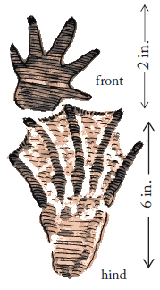Wildlife - Species


Beaver tracks
Beaver (Castor canadensis)
Description
The beaver is the largest rodent in North America. Shoulder height is generally 8 to 9 inches, but the back may be humped as high as
12 inches or more. Beavers are readily identified by their wide, flat leathery tails, which are used in dam building and for producing alarm
warnings. The fur color varies between individuals and ranges from blondish brown to dark brown. The beaver has a very dense, soft undercoat
overlayed with longer, stiffer guard hairs. Sexes cannot be distinguished externally. Beavers are well adapted to aquatic life with large webbed
back feet, nose and ear valves that can be closed, lips that close behind the teeth, and a nictitating membrane provides a transparent covering
for the eye.
Average Size
Adults average 35 to 40 lbs. and may exceed 60 lbs.
Life Expectancy
Approximately 24 years
Preferred Habitat
Beavers live in swamps, ponds and in streams. Beaver dams are constructed with sticks, logs and mud. The
length and height of the dam depend on the topography and can be elevated to raise the water level should the
beavers need to forage further into the woods. Beavers seldom venture far from water and often den in lodges
built from sticks and mud. However, where steep enough banks are available they prefer to dig a bank lodge with underwater entrances. The beaver’s habitat of damming creeks and streams often causes conflicts with human interests by flooding timber and agricultural land. However, the resultant wetlands are excellent habitat for raccoons, muskrats, otters and mink, as well as wood ducks and other waterfowl.
Range
Beavers are found in each of the 48 contiguous states and Alaska. They are present in portions of all 46 South Carolina counties.
Food Habits
Beavers are strictly vegetarians, eating leaves, twigs and the inner bark of trees. Favorite trees species are willows, sweet gum, and maple. The felling of trees for food is most common in the winter months. In the summer, beavers feed more on herbaceous plants and aquatic vegetation. They will also utilize nearby agricultural crops such as corn and soybeans. Lake front residents sometimes experience problems with beavers girdling ornamentals such as plums, cherries, and dogwoods.
Reproduction
Peak Breeding Activity
Beavers are primarily monogamous. Most breeding occurs in January and February.
Young beavers, called kits, venture out of the lodge at about 2 weeks of age and are weaned at 6 to 8 weeks. The young remain in the colony for nearly 2 years (22 months), at which time they become sexually mature and dispersal occurs.
Gestation
The gestation period is about 107 days, with litter sizes of 3 to 5.
Miscellaneous
Tularemia is a disease in beavers, often resulting in death. Trapping can control a population locally, and the young are subject to some predation by alligators and snapping turtles.
The beaver, once the most sought after furbearer in North America, was extirpated from South Carolina by the late 1800s through uncontrolled trapping. Beavers were reintroduced into the Pee Dee region of eastern South Carolina in 1940 by the U.S. Fish and Wildlife Service, and began to reinvade the Savannah River drainage from Georgia about the same time. These two populations of beaver have expanded their range, quickly moving towards each other. Beavers are expected to continue expanding until they reclaim all of their former range. In some areas beaver populations have grown to the point that they interfere with man’s interests and experienced trappers are necessary to control their numbers. High prices were once paid for beaver fur, but the demand has diminished in recent years to the point that trappers are usually contracted to remove nuisance beavers
Publications and Literature
Beaver Control - What a landowner CAN do in South Carolina
Baker, O.E., Carmichael, D. Breck, South Carolina Furbearers. Wildlife and Freshwater Fisheries Division. Columbia, South Carolina
Fur Harvest Hunting and Trapping are provided in the Fur Harvest Brochure which is a summary of the state statutes regarding the commercial harvest of furbearers. Applicable statutes are listed in parentheses at the end of each section of this brochure. Copies of actual statutes of the SC Code of Laws are available online from the SC Legislature at www.scstatehouse.gov or by writing: Furbearer Program, SC Department of Natural Resources, P.O. Box 167, Columbia, SC 29202.
Some of the files above are provided in the Adobe® Acrobat® (PDF) format. Adobe® Reader® is required to open these files and is available as a free download from the Adobe® Web site.
Jay Butfiloski - Furbearer Project Supervisor
SCDNR Furbearer Project
P. O. Box 167
Columbia, SC 29202-0167
Phone: 803-734-3886
Fax: 803-734-6020
E-mail: ButfiloskiJ@dnr.sc.gov
